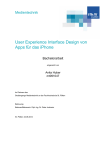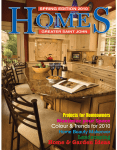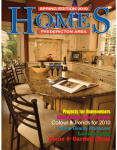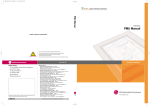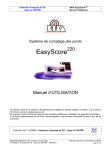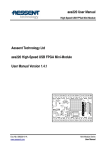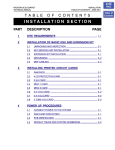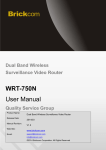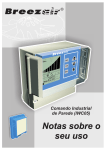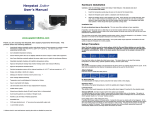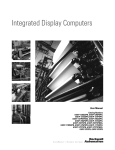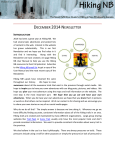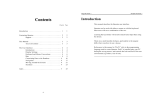Download Manual
Transcript
INSTALLATION AND OPERATING INSTRUCTIONS DSST SYSTEM PROPORTIONAL and NON-PROPORTIONAL TOGGLE SWITCH RADIO REMOTE CONTROL SYSTEM MODEL FHSTP/DSSTP SERIES FHST/DSST SYSTEM DESCRIPTION The DSST Wireless Control System is comprised of two major components; the handheld device and the receiver unit. The receiver is permanently attached to the equipment under control and allows for various operations by connecting directly to the existing electrical control system. The handheld device is the portable unit which the operator keeps by his side and uses to send commands back to the receiver to make the desired operational changes. The receiver is mounted in a polycarbonate Deutsch enclosure and is connected to the unit under control through supplied cables. Connectors on both control cables allow for convenient installation. It is powered from the same 12/24VDC system used to start and operate the unit engine. The radio signals from the handheld are received through either an internal receiver antenna or an externally mounted receiver antenna depending on the range requirement specific to the customer’s application. The handheld unit is a robust, custom designed ‘pistol grip’ unit. It uses a combination of toggle switches and speed control trigger to allow variable speed proportional machine control (note: nonproportional systems replace this trigger with a green safety switch). The handheld is powered by rechargeable Lithium Ion batteries. A charger for mobile applications with cigarette lighter adapter is included with the system to allow charging while at the job site. AC adapters are available by request. Two LED indicators are used to give the operator confirmation of signal transmission during operation and also to warn of low batteries. An audible ‘beep’ alarm will also indicate a low battery condition. The systems operate on a 2.4Ghz Direct Sequence Spread Spectrum radio band (in the case of the DSST system). The receiver is pre-programmed to operate with one specific transmitter. Replacement transmitters can be quickly field programmed by following the instructions later in this manual. It is strongly recommended that any radio control system be powered only when the equipment is parked and ready to work. A park-brake interlock switch for all air-brake truck applications is available from BASE Engineering at the time of order. April 2012 DSST Installation Guide, Rev. 5 Page 2 of 10 SYSTEM OPERATION General Operation Operation of the system requires that 12/24VDC power be applied to the receiver module. In most cases, this is done by connecting the RED wire on Cable 1 to a keyed, fused 12/24VDC source. After the switch is on, the BLUE light on the receiver will go ON solid. At this point the receiver is fully operational and is waiting for commands from the handheld unit. To operate the system: o Power on the receiver. The blue LED will go on solid. o Twist and pull the red E-Stop ON/OFF button to activate the handheld. Once the handheld is powered on, press a function toggle switch. This should make the Blue LED indicator on the handheld flash rapidly. When the toggle is released, the blue indicator will continue flashing, but at a slower rate. This indicates the handheld has not gone into a auto shutoff state (see page 4). NOTE: If the handheld is not proportional (no trigger), the green enable button on the handheld must first be pressed before operating a toggle. NOTE: Each time the receiver is powered on, it is important to properly ‘link’ the receiver and handheld. This can be done as follows: o Before powering on receiver, make sure the E-Stop button on the handheld is pressed. o Power on the receiver. o Twist and pull the E-Stop button on the handheld. The system will now be operational. When the user presses any function toggle on the handheld unit, the blue LED light on the receiver will also begin to flash and continue to do so as long as the function toggle is pressed. This light does not blink is when the handheld has gone into sleep mode, is turned OFF or has ceased to function (possibly caused by discharged batteries). If the batteries in the handheld become drained to a preset point, the red indicator will flash during button presses instead of the blue. An audible alarm will also sound at this point. This is to warn the operator that the handheld will need recharging soon. The user has approximately one hour of continuous operation time left before the handheld shuts down. Anti-2-Block (A2B) and Pressure Switch The receiver has the capability to interface with both a (pre-installed) A2B switch and a Pressure Switch. A2B o If the receiver reads a level change from this switch (ground to 12/24 or 12/24 to ground), it will shut down the Boom Out, Boom Down and Winch Up functions. This prevents the winch tackle from running into the boom and causing damage. o This feature allows the user to run the switch directly to the receiver, versus having to connect it into a ground circuit with the functions solenoids. Pressure Switch o If the receiver reads a level change from this switch (ground to 12/24 or 12/24 to ground), it will shut down the Boom Out, Boom Down and Winch Up functions. This prevents any over-pressure within the hydraulics. o This feature allows the user to run the switch directly to the receiver without having to install any external circuitry. April 2012 DSST Installation Guide, Rev. 5 Page 3 of 10 Note: The A2B and Pressure Switch options are not available on all systems. These options must be custom ordered. Please contact the factory for more information. Handheld Auto Shutoff The handheld unit has an auto shutoff feature that will turn off the handheld after a period of use. Features: The handheld shuts-down after 10 minutes of no use to conserve battery life. Prevents accidental activation if the handheld has not been used for more than 10 minutes and the estop button has not been pressed. After auto-shutdown has occurred, the estop remains active, allowing the user to press the estop button and send an estop signal to the receiver. Note that the blue LED on the handheld will stop flashing when auto shutoff has occurred. Handheld Battery Charging If the red LED and buzzer of the handheld indicate that the system charge is getting low, the unit should be recharged as soon as possible. To charge the batteries, unscrew the protective cap on the bottom of the handheld and connect the small plug of the supplied charger into the receptacle. Next plug the other end of the charger into the power receptacle of the truck. Ensure that power is available to this receptacle at all times. In some vehicles, the power to the receptacle is cut off when the ignition is off. While the handheld is charging, the blue LED will flash at a slow rate. When the unit is fully charged, the blue LED will remain ON solid. It will take up to four hours to charge the batteries from a fully depleted state. The handheld will remain operational while charging, allowing the operator to continue operations while the unit is charging if required. WARNING: Do not charge the handheld unit with any device other than the supplied BASE charger or damage to the unit may occur. NOTE: It is not recommended to charge the handheld in a cold environment such as overnight in the vehicle. This will severely limit the lifespan of the batteries. April 2012 DSST Installation Guide, Rev. 5 Page 4 of 10 SYSTEM INSTALLATION Receiver Module Select a suitable location for mounting of the receiver unit. The plastic enclosure, when properly installed is very resistant to water and other industrial contaminants. The receiver can be mounted anywhere on the equipment as long as there is an open, unobstructed path for the radio signal to reach the receiver/antenna. This will ensure maximum operational range. The enclosure should be mounted with the connectors facing down, to minimize the risk of water ingress through the connector pins. Please refer to the specific system drawings for size and mounting hole location. Power & Ground Connections Connect the RED lead of the system cable to a keyed and fused +12/24 VDC source. This power source must be active when the system under control is ON. Connect the BLACK lead to suitable electrical ground of the electrical system. Other Connections. Refer to attached system-specific drawing for the remaining connections. Handheld Unit Operation The handheld unit is shipped from the factory configured and ready for operation. It is recommended that the handheld unit be charged before it is put into operation. E-Stop ON/OFF button The E-Stop ON/OFF button must be in the out position for the system to operate. Pressing the E-Stop will turn off any active channel and turn off the handheld. To release the E-Stop twist the button in the direction of the arrows. The button will unlock and turn on the handheld. If the handheld is left ON but it is not operated for more than 10 minutes, the handheld will turn OFF and the E-Stop button will have to be pressed and released to reset the operation. Directional Movement To operate the directional controls in the handheld, the appropriate directional toggle must first be moved into position followed by slowly squeezing the speed control trigger until the desired motion speed is reached (only applies to proportional systems). Releasing the speed control trigger or directional toggle will stop the operation immediately. If the speed control trigger is pressed before the directional toggle is positioned the handheld will not operate. NOTE: If the handheld is not proportional (no trigger), the green enable button on the handheld must first be pressed before operating a toggle. April 2012 DSST Installation Guide, Rev. 5 Page 5 of 10 System Programming The DSST Wireless Control System is supplied from the factory fully programmed and ready for use, however, the following procedures can be used to re-program a replacement handheld or receiver unit if the field, as well as modifying minimum and maximum proportional output speeds. *NOTE: The user should ensure that there are no other operational handheld units within range of the system as they could interfere with the dedication process. Handheld Dedication Procedure. To dedicate the handheld to the receiver follow the steps described below: 1. Turn the receiver module on. The blue LED on the receiver should be solid (not flashing). 2. If the E-Stop button is not already pressed, press the E-Stop ON/OFF switch to the OFF position. Wait 5 seconds. 3. Rapidly release and press the E-Stop ON/OFF button five times in a row. Make sure that in the last press the E-Stop stays in the OFF position. 4. Wait for the RED LED (Battery indicator) to blink 5 times. 5. Press the green push button located near the grey connector on the receiver 5 times quickly. The blue LED will flash 5 times. Press the button once more. The blue LED will flash once, go solid, then flash 8 more times. 6. Once the blue LED on the receiver goes solid, the red LED in the Handheld should blink 6 times to indicated that the procedure was successful. If the handheld blinks only twice, repeat from step 1. Programming Instructions For Adjusting Minimum and Maximum Speeds on DSS*P Systems. (Not applicable to non-proportional systems) 1. Power on the Receiver and wait until initial startup has completed (Blue LED will stop flashing and go solid). 2. Turn on the handheld by twisting/pulling the Emergency Stop button. If already pulled but the handheld has shutdown due to timeout, press the Emergency Stop button, wait at least 1 second, then twist/pull the Emergency Stop button. 3. Proceed to section 4a if adjusting minimum speed. Proceed to section 5a if adjusting maximum speed. 4. Adjusting minimum speed (lowest attainable system speed): a. Press the programming button on the receiver quickly 3 times. The blue LED should blink 3 times in confirmation. If pressed incorrectly, the middle red LED will blink 4 times. Repeat this step. April 2012 DSST Installation Guide, Rev. 5 Page 6 of 10 b. Press the programming button on the receiver quickly 2 times. The blue LED should blink 2 times in confirmation. If pressed the incorrect number of times, the middle red LED will blink quickly 3 times. Repeat this step. c. The minimum speed can now be adjusted by the SETUP toggle on the handheld (top left position of the faceplate). Each press UP of the toggle will increase the minimum speed by 3%, up to a maximum of 40% of maximum speed (100%). Each press DOWN of the toggle will decrease the minimum speed by 3%, to a minimum of 0% of maximum speed (100%). d. The Receiver will update the new value after there has been no activity on the SETUP toggle for 3 seconds. There should be a brief flash of the middle red LED after the update is completed. e. Testing can now be done to verify if the adjustments are correct. This can be done by activating a function on the handheld and observing the results. As the minimum speed is increased, the joysticks/trigger will become more responsive. If more adjustments need to be done, go back to step 4c. f. Once adjustments have been completed, press the programming button on the receiver quickly 3 times. The blue LED should blink 3 times, stay solid for approximately 1 second, then blink 3 more times. Changes made are now permanent. 5. Adjusting maximum speed (maximum attainable speed when the joystick/trigger is fully displaced): a. Press the programming button on the receiver quickly 3 times. The blue LED should blink 3 times in confirmation. If pressed incorrectly, the middle red LED will blink 4 times. Repeat this step. b. Press the programming button on the receiver quickly 3 times. The blue LED should blink 3 times in confirmation. If pressed the incorrect number of times, the middle red LED will blink 3 times. Repeat this step. April 2012 DSST Installation Guide, Rev. 5 Page 7 of 10 c. The maximum speed can now be adjusted by the SETUP toggle on the handheld (top left position of the faceplate). Each press UP of the toggle will increase the maximum speed by 5%, up to maximum speed (100%). Each press DOWN of the toggle will decrease the maximum speed by 5%, to a minimum of 60% of maximum speed (100%). d. The receiver will update the new value after there has been no activity on the SETUP toggle for 3 seconds. There should be a brief flash of the middle red LED after the update is completed. e. Testing can now be done to verify if the adjustments are correct. This can be done by activating a function on the handheld and observing the results. As the maximum speed is increased, the maximum speed achieved when the joysticks/trigger is fully displaced is greater. If more adjustments need to be done, go back to step 5c. f. Once adjustments have been completed, press the programming button on the receiver quickly 3 times. The blue LED should blink 3 times, stay solid for approximately 1 second, then blink 3 more times. Changes made are now permanent. 6. Returning to factory defaults. a. If the factory speed defaults need to be restored, press the programming button quickly 15 times after receiver startup. The blue LED will flash 15 times. Factory speed defaults are now restored, and any previous changes are lost. System Troubleshooting Handheld Troubleshooting Blue LED does not flash when function operated. o Make sure Estop is pulled. o If Estop is pulled, press then pull Estop since auto shutdown may have occurred. o Make sure trigger is released before operating any toggles. o If above fail, plug in handheld with car charger and attempt to operate. If operation is ok, handheld needs to be charged. When plugging the handheld in to charge with the car charger, there is no activity on the blue LED. o Make sure there is power to the charger socket. o Make sure the correct charger is being used, i.e. the Li-ION battery charger from Base Engineering Inc. (12/24 volts) o Make sure the red LED on the outside of the charger lights when plugged in. If not, replace the charger fuse. o If above are correct, open the handheld and inspect the battery. Look for loose/broken connections from the wire to the connector, and make sure the connector is connected snugly to the PCB connector. When plugging the handheld in to charger with the car charger, the blue LED goes on solid, but does not flash. o This is normal if the battery is still fully charged. Allow the battery to run down through normal operation and attempt to charge again. April 2012 DSST Installation Guide, Rev. 5 Page 8 of 10 When pressing a toggle, both the red and blue LED’s flash simultaneously. o This indicates the trigger is pressed before the toggle. Release the trigger. If not pressed, move the trigger back and forth to check to see if it is stuck. Try the function again. Receiver Troubleshooting Blue LED not on when receiver powered on. o Cycle power. The blue LED will go solid. o Check power/ground connections. Blue LED on front of receiver on when power applied, but middle red LED is also on solid. o Open enclosure and replace 10A fuse. Blue LED is solid, but does not flash as expected when handheld function is pressed. o Make sure handheld is functioning properly (see later section of handheld troubleshooting.) o Make sure handheld being used is mated to the receiver in question (see dedication instructions if new handheld.) o If handheld is not proportional, make sure the green enable button is pressed before activating a toggle switch. Blue LED flashes when the handheld is operated, but function pressed does not activate, or activates but drops in/out quickly. o Check wiring for any poor connections/wrong connections. o Ensure ground wire is connected to chassis ground. o Current draw may be too large for channel output. Contact factory for more information. Proportional output is not responsive until near end of range on the joystick, and speed seems only on / off. o Make sure a proportional valve is being used. o Perform PWM minimum/maximum speed adjustments, using the instructions in the user manual. 1-3 outputs (boom down, boom out, winch up) are not functioning at all and the bottom red LED is blinking once. o Anti-2block is tripped. Make sure system is wired per drawing. Also, make sure the switch on the crane is not tripped. 1-3 outputs (boom down, boom out, winch up) not working and the bottom red LED is blinking twice. o Pressure switch on crane is tripped, or incorrect wiring has occurred. April 2012 DSST Installation Guide, Rev. 5 Page 9 of 10 For further details and product support please contact BASE Engineering Inc. @ 1.800.924.1010 BASE ENGINEERING INC. 600 ROTHESAY AVENUE SAINT JOHN NEW BRUNSWICK CANADA E2H 2H1 PHONE 1.800.924.1010 FAX 506.635.2281 E-MAIL [email protected] WWW.BASENG.COM FCC Rules and Compliance. This device complies with Part 15 of the FCC Rules. Operation is subject to the following two conditions: i. This device may not cause harmful interference, and ii. This device must accept any interference received, including interference that may cause undesired operation. FCC Part 15.231 Warning for RF Exposure for Mobile Equipment. This equipment has been approved for mobile applications where the equipment should be used at distances greater than 20cm from the human body (with the exception of hands, wrist, feet and ankles). Operation at distances less than 20cm is strictly prohibited. April 2012 DSST Installation Guide, Rev. 5 Page 10 of 10










